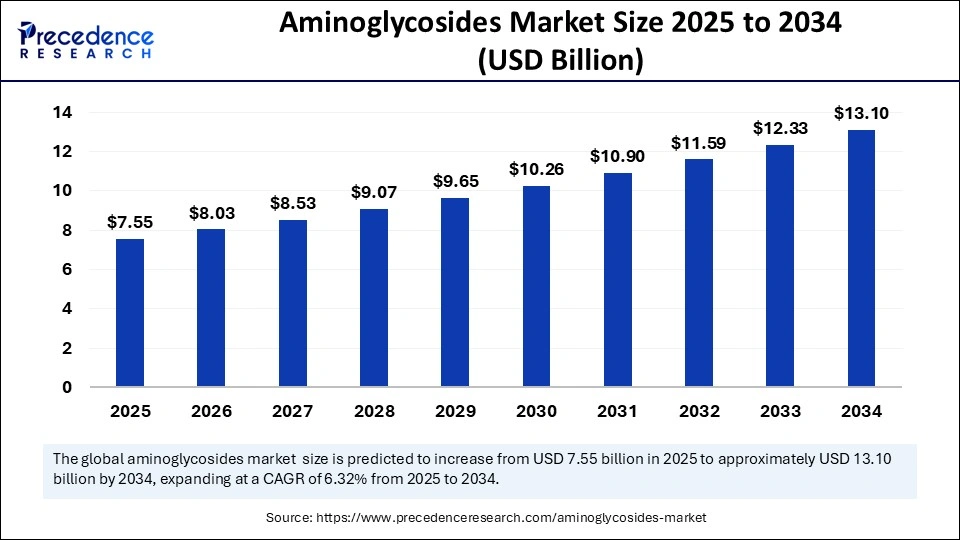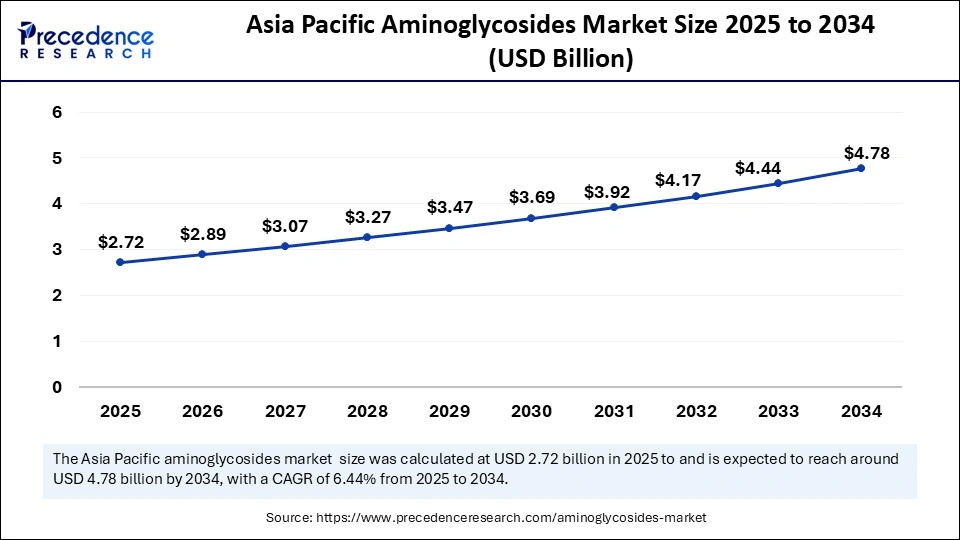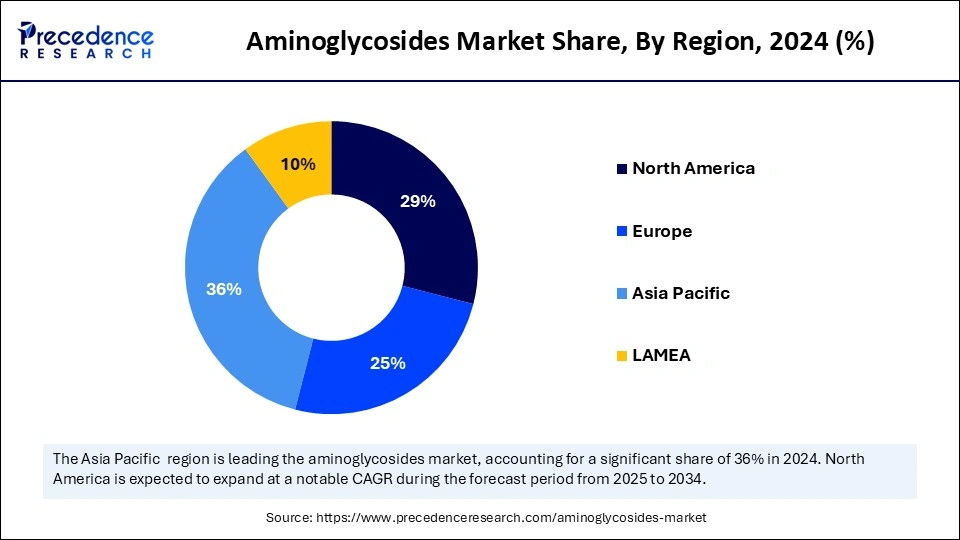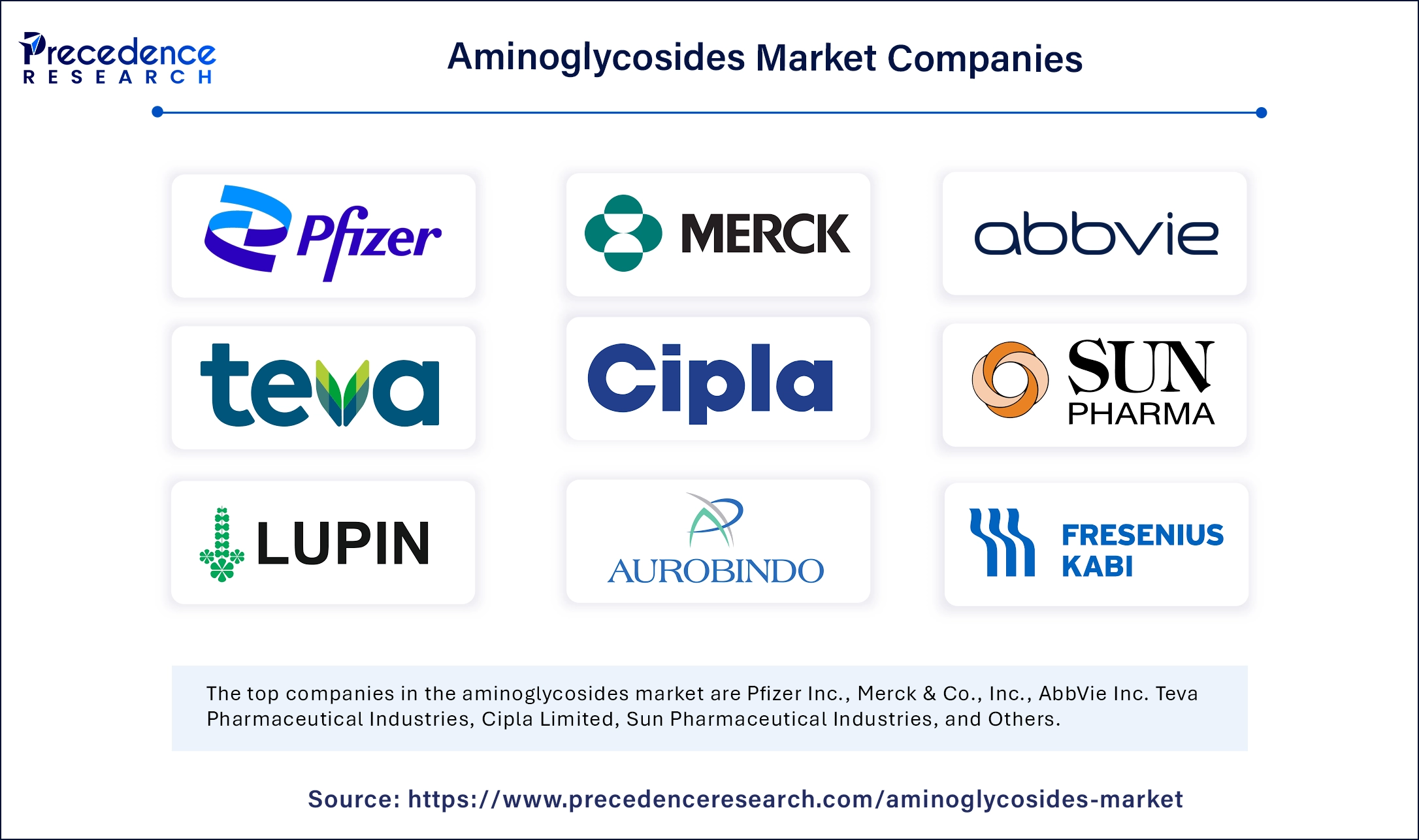What is the Aminoglycosides Market Size?
The global aminoglycosides market size is calculated at USD 7.55 billion in 2025 and is predicted to increase from USD 8.03 billion in 2026 to approximately USD 13.10 billion by 2034, expanding at a CAGR of 6.32% from 2025 to 2034.

Aminoglycosides Market Key Takeaways
- Asia Pacific dominated the aminoglycosides market with the largest share of 36% in 2024.
- North America is expected to grow at a notable CAGR between 2025 and 2034.
- By product, the gentamicin segment held the dominant share of the market in 2024.
- By product, the tobramycin segment is expected to grow at a significant rate in the coming years.
- By route of administration, the injectable segment dominated the market in 2024.
- By route of administration, the oral segment is likely to grow at the fastest rate during the forecast period.
- By application, the respiratory diseases segment dominated the market in 2024.
- By application, the skin infection segment is anticipated to expand at the highest CAGR during the projection period.
Market Overview
Aminoglycosides is an antibiotic, which is applicable in the treatment of aerobic gram-negative bacilli infections. They are effective against different bacteria, including Mycobacterium tuberculosis and Staphylococci. The major healthcare application of aminoglycosides is for the management of infectious and bacterial diseases. It is also used in the treatment of acute and chronic intestinal amebiasis and as an adjunct for the treatment of hepatic coma and to treat complicated urinary tract infections. Aminoglycosides are more effective against quickly multiplying organisms, and they affect and eventually destroy bacteria through different mechanisms. They need only a short contact with bacteria to kill them. The aminoglycosides market is witnessing rapid growth due to the rising prevalence of drug-resistant bacteria. Moreover, the rising R&D activities aimed at the development of new formulations support market expansion.
What Impact does AI have on the Aminoglycosides Market?
Artificial Intelligence AI revolutionizes the way infectious diseases can be controlled by accelerating the discovery ofantibiotics. AI helps in the development of new aminoglycoside formulations. AI models such as deep learning and machine learning help in resistance prediction, pathogen detection, and drug discovery. AI-based tools improve antibiotic stewardship and detect effective compounds like antimicrobial peptides and small molecules. AI also enhances drug discovery processes by improving precision and quality control. It analyzes vast datasets of compounds to identify potential aminoglycoside candidates with high affinity for bacterial targets. Moreover, AI analyzes patient data to predict individual responses to aminoglycosides. This further reduces the risks of complications and enhances patient outcomes.
Aminoglycosides Market Growth Factors
- The increased prevalence of multidrug-resistant bacterial infections led to renewed interest in aminoglycosides and efforts to develop advanced aminoglycosides. Aminoglycosides are potent, broad-spectrum antibiotics that act by inhibiting protein synthesis.
- Ongoing advances in drug delivery systems further support the growth of the market. Advanced drug delivery systems (DDSs) are formulated with enhanced properties like increased permeability, smaller particle size, enhanced solubility, efficacy, stability, and low toxicity. Advanced DDSs significantly improve the performance of the therapeutic agent.
- The growing demand for cost-effective and quality healthcare services and the increased awareness about infectious diseases boost the growth of the market.
Market Outlook
- Industry Growth Offerings- The aminoglycosides industry is growing due to rising antibiotic resistance and increasing bacterial infections. Key offerings include novel formulations, optimized dosing regimens, and combination therapies, targeting infectious diseases in hospitals, outpatient care, and veterinary applications.
- Global Expansion- The aminoglycosides market is expanding due to increasing prevalence of bacterial infections, rising demand in emerging economies, enhanced healthcare infrastructure, and investments by pharmaceutical companies in research, development, and distribution of advanced aminoglycoside formulations worldwide.
- Startup ecosystem- The aminoglycosides startup ecosystem is growing, with new companies focusing on developing safer, more effective antibiotics, innovative drug delivery systems, and solutions targeting multidrug-resistant bacteria, while exploring niche applications in human and veterinary healthcare.
Market Scope
| Report Coverage | Details |
| Market Size by 2034 | USD 13.1 Billion |
| Market Size in 2025 | USD 7.55 Billion |
| Market Size in 2026 | USD 8.03 Billion |
| Market Growth Rate from 2025 to 2034 | CAGR of 6.32% |
| Dominated Region | Asia Pacific |
| Fastest Growing Market | North america |
| Base Year | 2024 |
| Forecast Period | 2025 to 2034 |
| Segments Covered | Product, Route of Administration, Application and Region |
| Regions Covered | North America, Europe, Asia-Pacific, Latin America and Middle East & Africa |
Market Dynamics
Drivers
Emerging Infectious Diseases
The continuous expansion of the human population in the new geographical regions significantly increases close contact with animal species that may serve as hosts for infectious agents. This rising interaction, combined with the accelerating effect of the changing climate, has become a persistent catalyst in the emergence of infectious diseases. These diseases are caused by pathogenic microorganisms, like bacteria, viruses, parasites, or fungi, and can spread both directly and indirectly among human beings. This results in the increased demand for antimicrobial treatment, particularly aminoglycosides, which drives the growth of the market.
Restraint
Nephrotoxicity Challenges
Potential side effects associated with aminoglycosides hamper the growth of the aminoglycosides market. Aminoglycosides can induce nephrotoxicity, with an increase in serum creatinine and hypoosmolar urinary results developing after some days of the treatment. They are nephrotoxic due to a small but sizable proportion of the directed dose being retained in the epithelial cells lining the S1 and S2 segments of the proximal tubules after glomerular filtration.
Opportunity
Next-Generation Antibiotics
The widespread emergence of multidrug-resistant and communicable bacterial strains has created an urgent need for advanced antibiotic solutions, creating immense opportunities in the aminoglycosides market. The development of next-generation aminoglycoside antibiotics, such as plazomicin, is a breakthrough in combating highly resistant gram-negative pathogens. Plazomicin, a novel aminoglycoside, functions by binding to the bacterial 30S ribosomal subunit, thereby inhibiting protein synthesis in a concentration-dependent manner. It demonstrates a broad spectrum of activity against aerobic bacteria. This innovation not only enhances treatment efficacy but also opens new avenues for drug manufacturers.
Segment Insights
Product Insights
The gentamicin segment held the largest share of the aminoglycosides market in 2024. Gentamicin is used for the treatment of serious bacterial infections in various parts of the body. Gentamicin belongs to the class of medicines known as aminoglycoside antibiotics. It works by killing bacteria or preventing their growth. Gentamicin is an aminoglycoside antibiotic used to treat different types of bacterial infections, including endocarditis, bone infections, pneumonia, meningitis, pelvic inflammatory disease, urinary tract infections, and sepsis.
The tobramycin segment is expected to grow at a significant rate in the coming years. It has huge intrinsic activity against Pseudomonas aeruginosa and some gentamicin-resistant Acinetobacter baumannii and Pseudomonas aeruginosa strains. It is effective for treating external infections of the eyelid and eye caused by susceptible organisms. Tobramycin is an effective antibiotic normally used in the treatment and management of different ocular and systemic infections.
Route of Administration Insights
The injectable drugs segment dominated the aminoglycosides market with the largest share in 2024. Injectable aminoglycosides deliver an immediate, quick-acting therapeutic effect, which is significant in emergent conditions like narcotic overdose or cardiac arrest. They are very helpful in enhancing therapeutic effects as they can be completely absorbed as compared to medications given by other routes. Moreover, injectable aminoglycosides have proven to be highly effective in managing bacterial infections due to their enhanced safety and efficacy.
The oral segment is likely to grow at the fastest rate during the forecast period. Oral administration of medication is a cost-effective and convenient way. The primary site of drug absorption is commonly the small intestine, and the bioavailability of the drug depends on the quantity of drug absorbed across the intestinal epithelium. The oral route is usually the safest and most affordable; it is the most often used route of administration. Oral formulations are beneficial over injectable formulations, such as ease of administration and reduced side effects, which is a major factor boosting their demand.
Application Insights
The respiratory diseases segment held the largest share of the aminoglycosides market in 2024. This is mainly due to the increased number of cases of respiratory infections. Aminoglycosides are beneficial mostly in infections involving aerobic, Gram-negative bacteria, like Enterobacter, Acinetobacter, and Pseudomonas, which cause respiratory infections. Aminoglycosides are effective against gram-negative bacteria, which are common causes of respiratory infections like bronchitis and pneumonia.
The skin infection segment is anticipated to expand at the highest CAGR during the projection period. The growth of the segment is attributed to the rising prevalence of bacterial skin infections. Aminoglycosides are effective against a range of skin infections depending on the particular type and severity of the infection and the individual's circumstances. Common and effective skin infection antibiotics include cephalosporins, penicillin derivatives, trimethoprim-sulfamethoxazole, and clindamycin.
Regional Insights
Asia Pacific Aminoglycosides Market Size and Growth 2025 to 2034
The Asia Pacific aminoglycosides market size was exhibited at USD 2.72 billion in 2025 and is projected to be worth around USD 4.78 billion by 2034, growing at a CAGR of 6.44% from 2025 to 2034.

Asia Pacific dominated the aminoglycosides market with the largest share in 2024. This is mainly due to the increased healthcare research, improved capabilities of drug manufacturing, and commercialization of novel drugs. There is a high prevalence of infectious diseases, including bacterial infections. This significantly increased the demand for aminoglycosides.
China and India play a major role in the Asia Pacific aminoglycosides market. With the growing number of cases of infectious diseases in China, there is a strong focus on developing new formulations of aminoglycosides. Moreover, the prevalence of bacterial infections is rising in India due to the growing air and water pollution. The rising prevalence of infectious diseases in livestock further creates the need for aminoglycosides.
North America is projected to witness the fastest growth during the forecast period. The growth of the market in the region is mainly attributed to the increasing prevalence of infectious diseases, including bacterial infections, due to weather changes and the emergence of antibiotic-resistant strains. The increasing awareness among people about infectious diseases and health awareness campaigns support market growth. The growing aging population and per capita healthcare spending further contribute to regional market growth.

The U.S. is a major contributor to the North American market. The country is home to some of the leading pharmaceutical companies, which are focusing on novel drug discovery and development, creating opportunities for the aminoglycosides market. The emergence of antimicrobial resistance in the U.S. further supports market growth. Resistant germs that cause infections are complex and sometimes impossible to treat, which increases the need for aminoglycosides. Moreover, the U.S. government is investing heavily in developing modern treatments for a broad range of infectious diseases, driving the growth of the aminoglycosides market.
Europe Sees Rising Demand for Aminoglycosides Amid Infection Challenges
The Europe market is expanding due to the increasing prevalence of bacterial infections, including drug-resistant strains, across the region. Rising awareness of effective antibiotic therapies, growing healthcare infrastructure, and increased hospital admissions for infectious diseases drive demand. Additionally, ongoing R&D for new aminoglycoside formulations and government initiatives to combat antimicrobial resistance further support market growth in Europe.
UK Antibiotics: Market Strengthens as Aminoglycosides Combat Resistant Infections
The UK market is growing as healthcare providers increasingly rely on these antibiotics for rapid-acting treatment against severe and resistant infections. Rising outpatient and hospital-based infection cases, coupled with new formulation developments and enhanced distribution channels, are boosting accessibility and adoption. Additionally, initiatives to optimize antimicrobial therapies and ensure effective bacterial management are driving sustained demand in the region.
Value Chain Analysis
R&D
- R&D for aminoglycosides is resurging due to the growing need for antibiotics effective against multidrug-resistant (MDR) bacteria.
- Past concerns over toxicity and rising resistance had reduced their usage, but modern medicinal chemistry and improved drug delivery methods are mitigating these issues.
Key players: Pfizer, Novartis, Merck & Co., Gilead Sciences, and Johnson & Johnson,
Clinical Trials
- Clinical trials for aminoglycosides evaluate their effectiveness, dosing methods, and safety, often in comparison with other antibiotics.
- Current research emphasizes optimizing existing aminoglycosides to combat multidrug-resistant bacterial strains.
Key players:Pfizer, Novartis, Merck & Co., Gilead Sciences
Regulatory Approvals
- Regulatory approvals for aminoglycosides are overseen by national and regional authorities, evolving to address toxicity concerns and antimicrobial resistance.
- Agencies such as the U.S. FDA, European Medicines Agency (EMA), and others approve specific aminoglycosides for targeted bacterial infections while enforcing safety protocols.
Key players: Pfizer, Novartis, Merck & Co., Gilead Sciences, Johnson & Johnson,
Aminoglycosides Market Companies

- Pfizer Inc.: Offers a range of aminoglycosides and other antibiotics, focusing on innovative formulations, infectious disease treatments, and R&D for combating multidrug-resistant bacteria.
- Merck & Co., Inc.
- AbbVie Inc.:develops and markets antibiotics, including aminoglycosides, alongside therapies for chronic and infectious diseases, emphasizing safety and efficacy.
- Cilla Pharmaceuticals: Focuses on aminoglycoside production, generic antibiotics, and formulations for bacterial infections in human and veterinary applications.
- Teva Pharmaceutical Industries:Offers a wide portfolio of generic and specialty aminoglycosides, targeting bacterial infections with affordable and widely accessible treatments.
Other Major Key Players
- Cipla Limited
- Sun Pharmaceutical Industries
- Lupin Limited
- Aurobindo Pharma
- Fresenius Kabi
Recent Developments in the Market
- In February 2024, Cipla strengthens its fight against antimicrobial resistance by securing approval to introduce ZEMDRI injection in India. Plazomicin is a new intravenous (IV) aminoglycoside indicated for the treatment of complicated urinary tract infections (cUTI), including pyelonephritis.
- In March 2024, Insmed Incorporated, a global biopharmaceutical company on a mission to transform the lives of patients with serious and rare diseases, announced that it will present nine abstracts from across its respiratory portfolio at the American Thoracic Society (ATS) 2024 International Conference.
Segments Covered in the Report
By Product
- Neomycin
- Tobramycin
- Gentamicin
- Amikacin
- Paromomycin
- Streptomycin
- Kanamycin
- Others
By Route of Administration
- Injectable
- Feed
- Intra-mammary
- Topical
- Oral
By Application
- Veterinary
- Skin Infection
- Respiratory diseases
- UTI & Pelvic Diseases
- Other diseases
By Region
- North America
- Europe
- Asia Pacific
- Middle East & Africa
- Latin America
For inquiries regarding discounts, bulk purchases, or customization requests, please contact us at sales@precedenceresearch.com
Frequently Asked Questions
Ask For Sample
No cookie-cutter, only authentic analysis – take the 1st step to become a Precedence Research client
 sales@precedenceresearch.com
sales@precedenceresearch.com
 +1 804-441-9344
+1 804-441-9344